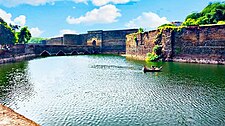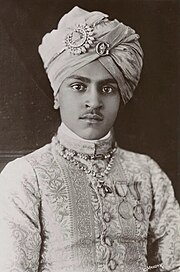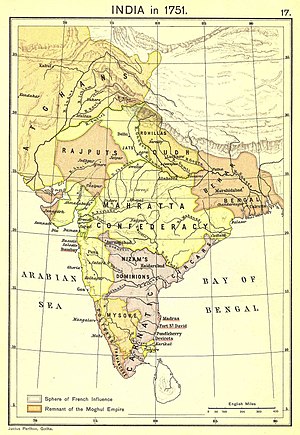Bharatpur State
Bharatpur State | |||||||||
|---|---|---|---|---|---|---|---|---|---|
| 1722–1947 | |||||||||
Imperial Gazetteer of India | |||||||||
| Capital | Bharatpur | ||||||||
| Common languages | Braj Hindi | ||||||||
| Government |
| ||||||||
| Maharaja | |||||||||
• 1722–1756 (first) | Badan Singh | ||||||||
• 1929–1947 (last) | Brijendra Singh | ||||||||
| Historical era | Medieval India | ||||||||
• Established | 1722 | ||||||||
| 15 August 1947 | |||||||||
| |||||||||
| Today part of | India · Rajasthan | ||||||||





Bharatpur State, which is also known as the Jat State of Bharatpur historically known as the Kingdom of Bharatpur, was a
History
The formation of the state of Bharatpur was a result of revolts by the
Gokula, a local Jat zamindar of Tilpat, led the first of such revolts in 1669. Even though the Jats were defeated and Gokula was executed, the movement was not completely crushed and discontent continued to simmer.[5] In 1685, there was a second uprising of the Jats under RajaRam of Sinsini, that was better organized this time and used guerrilla warfare, combining it with loot and plunder.[5] Now Aurangzeb approached the Kachhwaha ruler Bishan Singh to crush the uprising and appointed him as the faujdar of Mathura, granting him the entire area in zamindari. Conflict between Jats and Rajputs for zamindari rights also complicated the issue, with Jats primarily being landowners, whereas the Rajputs were primarily revenue collectors.[5] The Jats put up a stiff resistance but by 1691, RajaRam Sinsini and his successor Churaman were compelled to submit to the Imperial Mughals. However unrest among Jats continued and later on in the beginning of the 18th century, Churaman, taking advantage of the Mughal civil wars, was able to oust the Rajputs from the area and establish an independent state where Jat chiefs formed the ruling class.[5] Rajaram who also exhumed and burned the remains of Akbar is known for setting up a small fort at Sinsini. It was the key foundation of this kingdom.[7][8]The most prominent ruler of Bharatpur was Maharaja
The Jats were later defeated by the
In 1805, war between the
In August 1947, the state of Bharatpur acceded to the newly independent Dominion of India. In 1948, it became part of the Matsya Union and in 1949, it was absorbed into the state of Rajasthan. Members of the ruling family continue to be active in national and regional affairs. Several members of the family have served as members of parliament and in the state legislature.[15]
Expansion and decline
In the 1760s, the Kingdom of Bharatpur reached its zenith and covered present day capital

The Jats were later defeated by the
Military power
The Kingdom during Jawahar Singh's time had a large army of 25,000 Infantry, 15,000 Cavalry and 300 pieces of cannons with addition to the troops stationed at his forts.[17]
Rulers
The chronology of Sinsinwar dynasty rulers is as follows:
- Jai Singh II on 23 November 1722; he constructed the Royal Palace and Gardens at Deegas well as a temple at Dhir Samir ghat of Vrindavan. He was also an accomplished poet. He died 7 June 1756 at Deeg.
- Plunder of Old Delhi, Battle of Kumher, Capture of Agra and providing considerable assistance to the Maratha soldiers and civilians who escaped the Third Battle of Panipat. He established the Lohagarh Fortof Bharatpur.
- Maharaja Sawai Jawahar Singh, 1763–1768 (son of Maharaja Brajendra Surajmal Bahadur by Rani Ganga), 3rd Maharaja of Bharatpur 1763/1768; He led the Battle of Delhi and besieged the Red Fort, forcing the Rohillas to surrender and made the Mughals pay war indemnity to Jats. He returned to Bharatpur along with Lohiya gate and Ashtadhatu gate which had been brought to Delhi, by Alauddin Khalji after his Siege of Chittorgarh Fort in 1303. These doors are located in the Lohagarh Fort. He was assassinated at Agra in 1768 while hunting.
- Maharaja Ratan Singh, 1768–1769 son of Maharaja Brajendra Surajmal Bahadur by Rani Ganga), 4th Maharaja of Bharatpur 1768/1771 or 1768/1769, married and had issue. He too was murdered after a short reign.
- Maharaja Kehri Singh, 1769–1771, 5th Maharaja of Bharatpur 1771 or 1769/1776, died 1776.
- Maharaja Nawal Singh, 1771–1776 (son of Maharaja Brajendra Surajmal Bahadur by Rani Kavaria), Regent of Bharatpur 1771/1776, died 1776.
- two month siegehe was compelled to make peace and a new treaty was made on 4 May 1805, by which he was made to pay an indemnity of 20 lakhs, though he was confirmed in his possessions except for the parganas made over to him in 1803; married and had issue. He died in 1805.
- Maharaja Randhir Singh, 1805–1823, 7th Maharaja of Bharatpur, died 1823. An 1805 siegeby the British ended in the latter's withdrawal.
- Maharaja Baldeo Singh, 1823–1825, 8th Maharaja of Bharatpur, married and had issue. He died in 1825.
- Maharaja Durjan Sal, 1825–1826, 9th Maharaja of Bharatpur (usurper), opposed his cousin's accession and imprisoned him. British forces eventually laid siege to Bharatpur for three weeks and on 18 January 1826, the fort was stormed by troops under Lord Combermere and dismantled, the Maharaja was then imprisoned at Allahabad.
- Maharaja Balwant Singh, 1825–1853, 10th Maharaja of Bharatpur 1826/1853, born 1819, he was imprisoned by his cousin in 1825, but restored to the gadi in January 1826, under the Regency of his mother and the superintendence of the Political Agent, the Rani was removed later that same year and a Council of Regency was put in place; married and had issue. He died 1853.
- Jaswant Singh of Bharatpur, 1853–1893, 11th Maharaja of Bharatpur 1853/1893, born 1851, during his reign the State rendered loyal assistance to the British Government in 1857 and maintained order in the vicinity of Bharatpur; the state was administered by a Council under the Political Agent until 1872 when he was granted full ruling powers; married firstly, 1859, Maharani Bishan Kaur, daughter of Maharaja Narendra Singh of Patiala, married secondly, Maharani Darya Kaur, and had issue. He died 12 December 1893. Maharajkumar (name unknown) Singh (by Rani Bishan Kaur), died 4 December 1869. Maharaja Ram Singh (qv); Rao Raja Raghunath Singh, born 7 January 1887, educated at Mayo College, Ajmer 1895/1905 (Class-Captain 1903/1905), then with the Imperial Cadet Corps, Dehra Dun; he was appointed to the Bharatpur State Council in 1911, married and had issue. He died after 1930. Kunwar (name unknown) Singh, married and had issue. Kunwar (name unknown) Singh, married a daughter of Rai Amarjeet Singh of Kuchesar, and had issue.
- Shri Brijindar Si Maharaja Ram Singh Bahadur Jang, 1893 – 1900 (Exiled); 12th Maharaja of Bharatpur 1893/1900, born 9 September 1872 at Lohagarh, Bharatpur; installed 25 December 1893, removed from the administration of his state in 1895 and finally deposed in 1900 (#1); married firstly, Maharani Kishan Kaur, married secondly, Maharani Giriraj Kaur, died after 1918 and before 1931, and had issue, two sons and two daughters. He died 1929. Lt.Col. Shri Maharaja Shri Brajendra Sawai Kishen Singh Bahadur Jang (by Maharani Giriraj Kaur)(qv) Maharaj Giriraj Singh; Maharajkumari Gajindar Kaur; Maharajkumari Gokul Kaur
- Maharani Giriraj Kaur, regent 1900–1918.
- Lt.Col. Shri Maharaja Shri Brajendra United Provinces. Maharajkumari Bibiji (name unknown) Kaur, died 19 May 1930 at Mussoorie. Maharajkumari Bibiji Padma Kaur (Kunwarani Vrish Bhan Kunwar), born 18 September 1919, married Kunwar Brijendra Singh of Moradabad District., and had issue. She died 1945 in Mysore.[citation needed]
- Colonel Shri Maharaja Brajendra Sawai instrument of accession to the Indian Union), 14th Maharaja of Bharatpur 1929/1995, born 1 December 1918; he succeeded to the gadi on 14 April 1929; Member of the Lok Sabha 1962/1971; married firstly June 1941, Yuvarajkumari Jaya Chamunda Ammani Avaru [the Maharani of Bharatpur], died 1954, daughter of Yuvaraja Sir Sri Kantirava Narasinharaja Wadiyar of Mysore, and his wife, Yuvrani Kempu Cheluvammanniyavaru, married secondly, 1961 (div. 1972), Maharani Videh Kaur of the Urs family of Mysore, born 1933, died 1985, by whom he had issue. He died 8 July 1995.[citation needed]
The line is nominally continued
- Shri Maharaja Shri Brajendra Sawai Vishvendra Singh Bahadur Jang, 15th Maharaja of Bharatpur.[18]
Symbols

The former flag of the princely state was a rectangular tricolor with three horizontal stripes of saffron, white and blue. Its design and colour scheme happened to be very similar to the official flag that would be adopted for the future independent Dominion of India.[citation needed]
In the last three years before joining the Indian Union a new flag was adopted for Bharatpur that had a broad Chartreuse coloured band and the coat of arms in the middle.[19] During that brief period (c.1943 – 1947) Bharatpur became the only political entity ever to have a chartreuse coloured flag. Bharatpur State also had an elaborate coat of arms.[20]
See also
References
- ISBN 978-0-230-32885-3.
- ^ "Lohagarh Fort". 10 February 2024.
- ^ "Lohagarh Fort: कोई नहीं जीत पाया ये किला, 13 बार हमले के बाद अंग्रेज भी हो गए थे असफल". 5 February 2024.
- ^ History of Deeg Palace in Bharatpur
- ^ a b c d e Chandra, Satish (1990). Medieval India. India: National Council for Educational Research and Training. pp. Chapter 18 p. 295, 296.
- ^ History of jats state during 17th century
- ^ Kunj Bihari Lal Gupta. The Evolution of the Administration of the former Bharatpur State. Vidya Bhawan Publishers, Jaipur, 1959.
- ^ Tony McClenaghan. Indian Princely Medals: A record of the Orders, Decorations and Medals of the Indian Princely States. Lancer Publications, Spantech & Lancer, New Delhi, 1996.
- ^ Bhatia, O. P. Singh (1968). History of India, from 1707 to 1856. Surjeet Book Depot. p. 536.
- ^ "Taj Mahal". MANAS. Retrieved 25 May 2021.
- ^ Prakash Chandra Chandawat: Maharaja Suraj Mal aur unka yug, Jaypal Agencies Agra, 1982, Pages 197–200
- ^ a b "Najafgarh: A Kingmaker in the Capital". Live History India. Retrieved 25 May 2021.
- ISBN 978-1-647-83961-1.
- ^ "Princely States of British India - Card Game". www.Heritageshaala.com.
- ^ "Vishvendra Singh Bharatpur".
- OCLC 1067771105. Retrieved 20 December 2019.
- ISBN 978-81-250-0333-5.
- ^ "Genealogy of Bharatpur". Archived from the original on 1 April 2009.
- ^ Flags of Bharatpur – Roberto Veschi
- ^ "Bharatpur Rajasthan Travel Guide", www.indyabiz.com, retrieved 28 June 2021
Notes
- Imperial Gazetteer of India Vol 8, P-73 Bharatpur State
- ISBN 0-333-90298-X, p. 535-36
- Attribution
This article incorporates text from a publication now in the public domain: Chisholm, Hugh, ed. (1911). "Bharatpur". Encyclopædia Britannica (11th ed.). Cambridge University Press.
External links
- Bharatpur State at Britannica
 Media related to Bharatpur State at Wikimedia Commons
Media related to Bharatpur State at Wikimedia Commons


